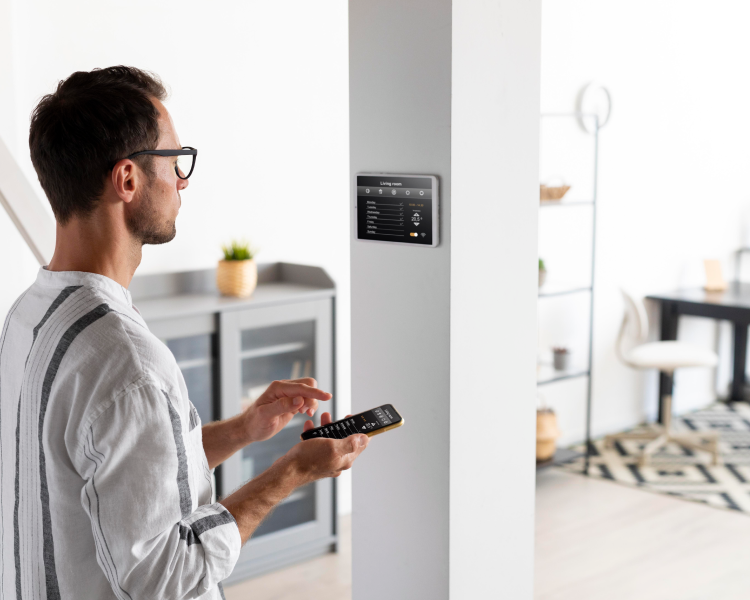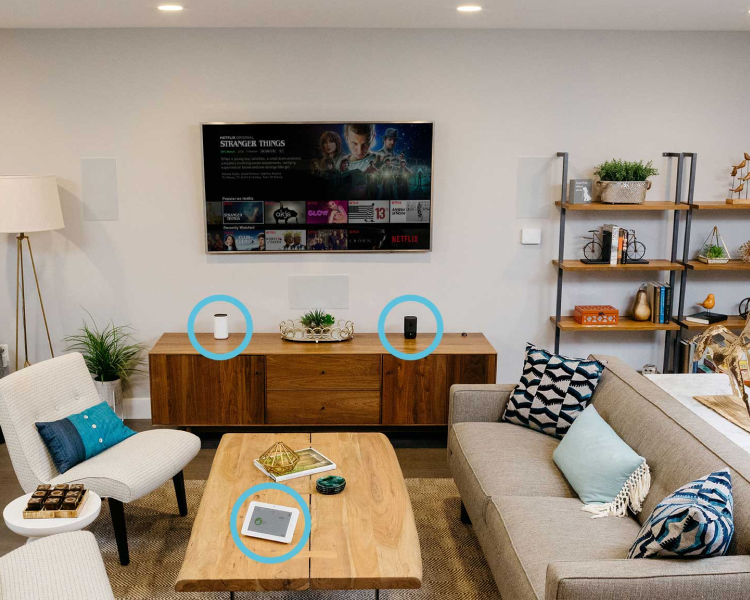Stellen Sie sich vor, Sie kommen nach einem langen Arbeitstag nach Hause und mit einem einfachen Sprachbefehl oder einer Berührung leuchten Ihre Lichter allmählich auf und der Thermostat passt sich Ihrer Wunschtemperatur an. Das klingt unwirklich, oder? Nicht mehr. Node-RED macht all das möglich und bringt Ihnen die Automatisierung auf Knopfdruck. Es ist nicht nur ein Werkzeug, es ist ein Wendepunkt in der Welt der Heimautomatisierung. Aber was ist Node-RED?
Node RED ist ein visuelles Programmiertool, mit dem Sie Geräte, APIs und Onlinedienste auf intuitive Weise miteinander verbinden können. Von der Anpassung intelligenter Beleuchtungsszenarien über die Integration von Sicherheitssystemen bis hin zur Erstellung komplexer Routinen – Node-RED erledigt alles. Aufgrund seines Open-Source-Charakters und der aktiven Community-Unterstützung sind die Automatisierungsmöglichkeiten praktisch unbegrenzt.
Lassen Sie uns besprechen, was Node RED ist, sowie seine Funktionen, Beispiele und mehr!
- Was ist Node RED?
- Möchten Sie sich mit der Funktionalität von Node-RED befassen?
- Erstellen einer Node-RED-Funktion – Schritt-für-Schritt-Anleitung
- Anwendungen der Node-RED-Funktion
- Was ist ein Node RED-Beispiel?
- Was ist das Node RED Dashboard?
- EVVR Center Lite - Smartes Hausautomatisierungssystem
Was ist Node RED?
Was ist Node RED? Es handelt sich um ein Open-Source-Tool für visuelle Programmierung, das Geräte, APIs und Onlinedienste auf intuitive und flussbasierte Weise miteinander verbindet. Es vereinfacht den Prozess der Erstellung von Automatisierungs- und Integrationsflüssen mithilfe von Knoten und ist für Benutzer mit unterschiedlichem technischen Fachwissen zugänglich.
Node-RED wurde ursprünglich 2013 von IBM Emerging Technology eingeführt .
Nachdem Sie nun wissen, was Node RED ist, besprechen wir, wie es Ihnen die Erstellung industrieller IoT-Anwendungen erleichtert:
- Erstens bietet es eine umfangreiche Bibliothek vorgefertigter Knoten, die Entwicklern eine Fülle von Funktionen bietet. Diese Knoten ermöglichen die nahtlose Ausführung komplexer Aufgaben wie die Datenübertragung über Protokolle wie MQTT, Modbus/TCP oder E-Mail.
Derzeit sind über zweitausend Knoten verfügbar, und die Open-Source-Community leistet laufend Beiträge. Dieses Node-RED stellt einen ständig wachsenden Satz an Ressourcen für industrielle IoT-Anwendungen sicher.
- Node-RED ist ein grafisches Entwicklungstool, bei dem die Knoten jeder Anwendung strategisch auf einer Leinwand positioniert und miteinander verbunden sind. Jedem Knoten wird eine bestimmte Rolle zugewiesen – sei es das Sammeln, Verarbeiten oder Übertragen von Daten. Diese grafische Benutzeroberfläche verbessert die Zugänglichkeit und erleichtert die Erstellung von IoT-Anwendungen.

Möchten Sie sich mit der Funktionalität von Node-RED befassen?
Nachdem Sie nun wissen, was Node Red ist, ist es Zeit, die Node RED-Funktionen zu besprechen!
Was ist die Node RED-Funktion?
In Node-RED ist eine Funktion ein Knotentyp, der es Entwicklern ermöglicht, JavaScript-Codeausschnitte hinzuzufügen, um Daten innerhalb eines Flusses zu bearbeiten oder zu transformieren. Sie dient als vielseitiges Tool zum Ausführen benutzerdefinierter Operationen an den Eingabedaten, bevor diese an den nächsten Knoten in der Sequenz übergeben werden. Das JavaScript-Objekt mit der Bezeichnung „msg“ wird zum Übermitteln von Daten zwischen Knoten verwendet, und der Inhalt der Nachricht ist über die msg-Nutzlast zugänglich.
Jetzt wissen Sie, was Node Red ist. So können Sie eine Nachrichtennutzlast und ein Nachrichtenthema in der Node-RED-Funktion bewerten und ändern:
Um auf die Nutzlast der Nachricht zuzugreifen, können Sie Folgendes verwenden:
- var Nutzlast = Nachricht.Nutzlast;
Um die Nutzlast zu ändern, verwenden Sie Folgendes:
- Nutzlast = Nutzlast;
So greifen Sie auf das Nachrichtenthema zu:
- var Thema = Nachricht.Thema;
Und zur Modifizierung des Themas:
- Thema = Thema;
Erstellen einer Node-RED-Funktion – Schritt-für-Schritt-Anleitung
Hier ist die Anleitung, der Sie zum Erstellen einer Node-RED-Funktion folgen können:
- Stellen Sie sicher, dass Node-RED in Ihrem Webbrowser installiert und ausgeführt wird, bevor Sie eine Funktion erstellen.
- Stellen Sie eine Verbindung zu Ihrer lokalen Node-RED-Instanz her, indem Sie dem bereitgestellten Link folgen.
- Navigieren Sie in der linken Seitenleiste des Editors durch kategorisierte Knoten.
- Suchen Sie unter der Funktionskategorie den Funktionsknoten.
- Klicken Sie auf den Funktionsknoten und ziehen Sie ihn auf die Arbeitsfläche, um die Automatisierung Ihres Workflows zu starten.
- Doppelklicken Sie auf den Funktionsknoten, um das Konfigurationsfenster zu öffnen.
- Passen Sie den Namen der Funktion im Feld Name an, um eine eindeutige Beschriftung im Arbeitsbereich zu erhalten.
- Unter dem Feld „Name“ finden Sie verschiedene Registerkarten zum Konfigurieren und Schreiben kontextbezogener JavaScript-Logik.
- Wenn Sie eine Logik haben, die beim Start des Knotens ausgeführt werden soll, verwenden Sie die Registerkarte „Beim Start“. Dieser Code wird einmal ausgeführt.
- Auf der Registerkarte „Beim Stoppen“ schreiben Sie Code für Aktionen während des Stoppens oder der erneuten Bereitstellung eines Knotens.
- Die primäre Logik für Ihre Funktion befindet sich auf der Registerkarte „Bei Nachricht“. Hier handhaben Sie Aktionen, die durch eingehende Nachrichten ausgelöst werden.
Wenn Sie die angegebenen Schritte befolgen, können Sie effektiv eine Node-RED-Funktion erstellen und anpassen, die Ihren spezifischen Automatisierungsanforderungen entspricht.

Anwendungen der Node-RED-Funktion
Hier sind einige Anwendungen von Node-RED-Funktionen:
Datentransformation
Node-RED-Funktionen sind bei der Datentransformation von zentraler Bedeutung und ermöglichen Ihnen die Konvertierung von Daten zwischen verschiedenen Formaten. Ob es sich um die Umstrukturierung von Datenstrukturen, die Konvertierung von Zeitstempeln oder das Extrahieren bestimmter Felder handelt, diese Funktionen bieten Ihnen eine flexible und effiziente Möglichkeit, Daten an Ihre spezifischen Anforderungen anzupassen.
Datums- und Uhrzeitmanipulation
Node-RED-Funktionen glänzen auch beim Umgang mit zeitlichen Aspekten von Daten und ermöglichen Ihnen die nahtlose Bearbeitung von Datum und Uhrzeit. Es passt Zeitstempel an, erstellt Zeitpläne oder führt andere zeitbezogene Vorgänge aus. Sie können Ereignisse innerhalb Ihres Automatisierungsflusses steuern und synchronisieren und so zur Präzision und Zuverlässigkeit Ihres Systems beitragen.
Textverarbeitung
Innerhalb von Node-RED eignen sich Funktionen für die Textverarbeitung und stellen ein leistungsstarkes Werkzeug zum Bearbeiten und Extrahieren von Informationen aus Textdaten dar. Sie können diese Funktionen zum Parsen, Extrahieren oder Ändern von Textzeichenfolgen verwenden, was sie für verschiedene Aufgaben unverzichtbar macht.
Mathematische und statistische Operationen
Node-RED-Funktionen erweitern ihre Fähigkeiten um verschiedene mathematische und statistische Operationen. Von der Berechnung von Durchschnittswerten bis zur Aggregation von Daten ermöglichen Ihnen diese Funktionen die nahtlose Integration analytischer Funktionen in Ihre Automatisierungsabläufe. Diese Vielseitigkeit fügt dem System eine Intelligenzebene hinzu und ermöglicht datengesteuerte Entscheidungsfindung innerhalb der Automatisierungsumgebung.
Node-Red-Variablen
Hier sind zwei häufige Variablen, die in Node-RED-Funktionen verwendet werden:
- Globale Variablen: Variablen in einem globalen Kontext haben einen größeren Umfang und können von Knoten in jedem Flow innerhalb der Node-RED-Instanz aufgerufen werden. Sie eignen sich für den globalen Datenaustausch zwischen verschiedenen Teilen Ihrer Node-RED-Anwendung.
- Flussvariablen: Im Flusskontext gespeicherte Variablen sind für Knoten innerhalb desselben Flusses zugänglich. Sie sind nützlich für die Datenübertragung zwischen Knoten in derselben Flussinstanz.
Was ist ein Node RED-Beispiel?
Ein Beispiel für Node-RED könnte die Erstellung eines einfachen Ablaufs zur Steuerung intelligenter Lichter auf der Grundlage eines Bewegungssensors sein. Hier ist eine kurze Anleitung:
Drag & Drop-Knoten:
- Ziehen Sie einen „mqtt in“-Knoten zum Empfangen von Nachrichten von einem Bewegungssensor.
- Fügen Sie einen „Switch“-Knoten hinzu, um Nachrichten basierend auf der Bewegungserkennung zu filtern.
Knoten verbinden:
- Verbinden Sie den Ausgang des Knotens „mqtt in“ mit dem Eingang des Knotens „switch“.
Knoten konfigurieren:
- Konfigurieren Sie den Knoten „mqtt in“, um das Bewegungssensorthema zu abonnieren.
- Richten Sie den „Switch“-Knoten so ein, dass Nachrichten gefiltert werden, wenn eine Bewegung erkannt wird.
Funktionsknoten hinzufügen:
- Fügen Sie einen „Funktions“-Knoten ein, um die Logik anzupassen.
- Verwenden Sie innerhalb des Funktionsknotens JavaScript, um zu bestimmen, ob es Tag oder Nacht ist.
Kontrollleuchten:
- Verbinden Sie den Ausgang des Funktionsknotens mit einem „MQTT-Out“-Knoten, um Befehle an intelligente Lichter zu senden.
- Konfigurieren Sie den Knoten „mqtt out“, um Nachrichten zum Thema „Smart Lights“ zu veröffentlichen.
Stellen Sie den Flow bereit:
- Klicken Sie auf „Bereitstellen“, um den Flow zu aktivieren.
Was ist das Node RED Dashboard?
Das Node-RED Dashboard vereinfacht die Erstellung interaktiver webbasierter Benutzeroberflächen für IoT- und Heimautomatisierungsprojekte . Es ist ein Visualisierungstool, mit dem Sie die Smart-Home-Automatisierung über ein anpassbares und benutzerfreundliches Dashboard überwachen und steuern können.
Hier sind einige Komponenten des Node-RED-Dashboards:
- Intuitive Visualisierung : Das Node-RED Dashboard bietet eine benutzerfreundliche Oberfläche mit intuitiven Visualisierungen, die eine einfache Überwachung und Steuerung von Automatisierungsabläufen ermöglicht.
- Vielfältige Widget-Bibliothek : Verschiedene Widgets, darunter Messgeräte, Diagramme und Schalter, ermöglichen Benutzern die Darstellung und Interaktion mit Daten auf vielfältige Weise.
- Echtzeit-Updates : Unterstützt Echtzeit-Updates und gewährleistet eine sofortige Anzeige von Änderungen an zugrunde liegenden Daten oder Gerätezuständen auf dem Dashboard.
- Anpassbare Layouts : Benutzer können das Layout des Dashboards anpassen und Widgets nach ihren Wünschen anordnen, um ein optimiertes Benutzererlebnis zu erzielen.
Welche Rolle spielt Node RED bei der Heimautomatisierung?
Schauen wir uns an, welche Rolle Node RED bei der Heimautomatisierung spielt:
- Fernsteuerung: Über das Dashboard können Benutzer Smart-Geräte fernsteuern. Sie können beispielsweise direkt vom Dashboard aus Lichter ein- und ausschalten, die Einstellungen des Smart-Thermostats anpassen oder Türen ver- und entriegeln.
- Warnungen und Benachrichtigungen : Mit der Funktionalität von Node RED ist das Dashboard so konfiguriert, dass es auf der Grundlage vordefinierter Bedingungen Warnungen und Benachrichtigungen sendet und Sie so für kritische Ereignisse sensibilisiert.
- Geräteüberwachung: Bietet eine zentrale Plattform zur Überwachung des Status verschiedener Smart-Home-Geräte. Sie können den Zustand von Sensoren, Lichtern, Thermostaten, intelligenten Lautsprechern und mehr schnell beurteilen.
EVVR Center Lite
Das EVVR Center Lite ist ein Smart Hub, der sich nahtlos an Ihren Lebensstil anpasst. Es verfügt über eine EVVR-Konsole mit fortschrittlichem und zukunftsorientiertem Workflow-Design und bietet eine benutzerfreundliche Oberfläche. Es vereinfacht auch die Erstellung von Treibern für Zigbee 3.0- und Z-Wave Plus-Geräte. Sie können damit das Hausautomationssystem mühelos aktivieren und Probleme einfach beheben.
Es spielt keine Rolle, ob Sie den großen Bildschirm oder die intuitive App verwenden – Freiheit und Komfort in jedem Raum. Außerdem sind Sie für die Kommunikation zwischen mehreren Smart-Geräten nicht mehr vom Internet abhängig. EVVR Center Lite richtet ein robustes lokales Netzwerk ein, in dem Geräte nahtlos kommunizieren und auch ohne Internetverbindung eine unterbrechungsfreie Konnektivität gewährleisten.
Was uns auszeichnet, ist unser Engagement für den Datenschutz! Alle Ihre sensiblen Daten werden in Echtzeit lokal verarbeitet und gespeichert, sodass Sie eine sichere und private Heimautomatisierung genießen können. Aber das ist noch nicht alles. EVVR ist führend in Sachen Innovation und entwickelt aktiv die Unterstützung des Matter-Protokolls, um Ihr Produkterlebnis zu verbessern.

Hauptmerkmale
- Nahtlose Automatisierung: Intuitive EVVR-Konsole zum mühelosen Erstellen von Treibern für Zigbee 3.0- und Sub-1-GHz-Geräte.
- Flexible Fehlerbehebung : Erweitertes Workflow-Design für eine benutzerfreundliche Oberfläche, die die Problemlösung auf einem großen Bildschirm oder einer App vereinfacht.
- Offline-Konnektivität : Durch die lokale Netzwerkkommunikation können mehrere Smart-Geräte eine Verbindung herstellen, ohne auf das Internet angewiesen zu sein.
- Datenschutzgarantie : Lokale Echtzeitverarbeitung und -speicherung privater Daten, um Vertraulichkeit und Sicherheit zu gewährleisten.
- Remote-Sicherheit : Zuverlässige Peer-to-Peer-Netzwerkverbindung mit robuster Datenverschlüsselung für sicheren Remote-Zugriff.
Abschluss
Was ist Node RED? Node-RED ist eine dynamische und vielseitige Plattform, die sowohl Anfängern als auch erfahrenen Entwicklern in den Bereichen Automatisierung und IoT hilft. Durch seinen visuellen Programmieransatz vereinfacht Node RED den Prozess der Verkabelung von Geräten, APIs und Onlinediensten. Es macht die Heimautomatisierung für Hausbesitzer und Technikfreaks gleichermaßen viel einfacher.
Wenn Sie auf der Suche nach Smart-Home-Geräten mit einer intuitiven Benutzeroberfläche sind, ist EVVR die richtige Anlaufstelle. Wir haben Smart-Home-Lösungen wie EVVR Energy Monitoring Smart Plug and Relay, EVVR Pad S, EVVR Smart In-Wall Relay Switch und mehr. Nehmen Sie Kontakt mit uns auf und verbessern Sie Ihren Lebensstil.











